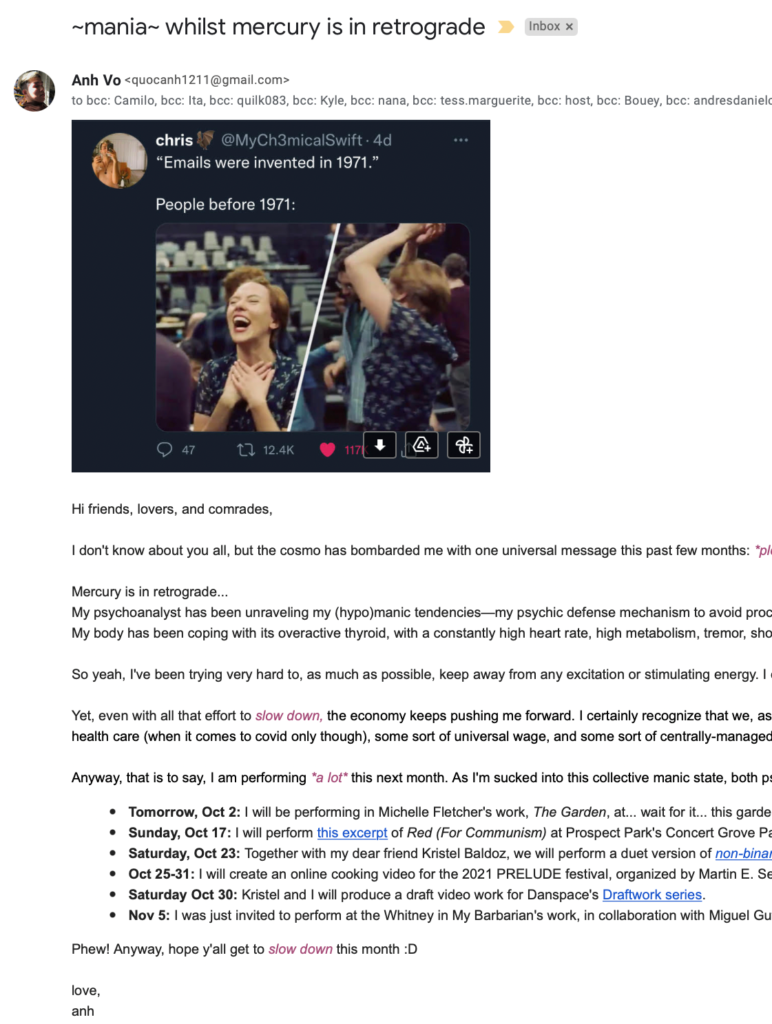Art in Your Inbox—5 Tips for Creating an Effective Email Newsletter
If you’ve dabbled in sporadically messaging your friends and frequent audience members to alert them about your upcoming shows, it might be time to upgrade to an official email newsletter. At the very least, you’ll streamline your recipient list, systematize how and when you share updates, and work towards developing a written voice and brand that feels reflective of your artistic aesthetic. Though you might enjoy the frills that come with using an email marketing platform like Mailchimp or Constant Contact, you can also create a more-than-serviceable newsletter with a basic email account. You just need to carefully consider your e-newsletter’s layout, timing and overall vibe before sending off your first missive.
Send Your Newsletter When You Have News

When deciding whether to send an email blast on behalf of Sidra Bell Dance New York, executive producer of publicity, web design and marketing Claudette Bell (and mother of Sidra) prefers to think of timing in terms of upcoming events. “We look at what the SBDNY calendar looks like and work from there,” she says. A typical newsletter, which goes out every one to two months on average, might lead with a recap of Sidra’s latest premiere—including press quotes, photos and additional performance dates—and also include upcoming workshops, classes or guest-artist residencies.
Dancer, writer and teacher Anh Vo takes a similarly event-driven approach. “This summer I sent three back-to-back, because so many things were happening,” they say. “I don’t have any rules when it comes to timing. There’s some breathing room when you’re not a business.”
Vary the Media You Include
“Know your audience,” advises Claudette. Sidra collaborates regularly with photographers and always has new graphic and multidimensional images to include in email marketing campaigns. Vo, on the other hand, chooses to break up what they describe as a “wall of text” with tweets or memes they’ve recently come across and screenshotted. “I appreciate pop culture,” they say. “There’s something there—laughter, maybe, or connection.”
Don’t Be Afraid to Ask People to Join Your Mailing List

“Sidra’s email list has been developing since 2001—it started with friends from college,” says Claudette, who now says the subscriber total is near 10,000. At every concert and reception, she makes sure to include a program insert with mailing-list information, or have a physical sign-up sheet handy.
Vo will often post an Instagram Story ahead of an upcoming e-blast, asking if anyone would like to receive it. “There’s a chat-box function you can use where people can enter their emails,” says Vo. They also have an option on their personal website for visitors to opt in to their email list.
Create Something You’d Want to Read
Vo cites Miguel Gutierrez’s “spewsletter” as an email blast that they enjoy opening and reading immediately. “That’s what I strive for with my own writing,” says Vo. “I don’t think about capturing people’s attention but crafting an experience with the email, assuming they’ll go from the beginning to the end.”
Aim for Absolute Accuracy
Double- and triple-check that names, event titles, venues, dates and any other proper nouns you include in your newsletter are correct. “And credit your contributors,” says Claudette. A correction email is rarely a good look.
Email Marketing Platforms
Mailchimp offers a free version for those with a subscriber list of 2,000 or fewer. (There are also essential, standard and premium plans, with tiered monthly rates.) The platform lets you customize easy-to-use templates, and every plan includes some audience-engagement analytic tools.
Constant Contact has two plans. Both have tiered pricing, based on the number of contacts you have. Though Constant Contact has more than 100 templates to choose from, the interface isn’t as straightforward as Mailchimp’s, and there are fewer audience-insight tools.
Gmail is Anh Vo’s preferred platform. They feel a personal email seems to inspire more dialogue. “People respond, I get back to them—there’s more conversation happening,” says Vo.




